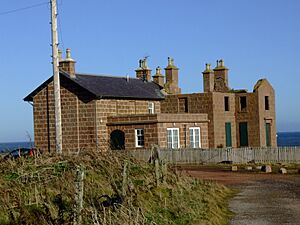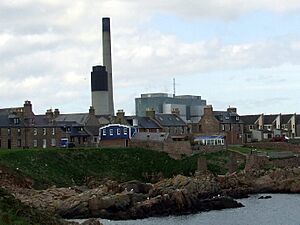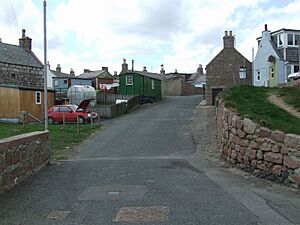Boddam, Aberdeenshire facts for kids
Quick facts for kids Boddam |
|
|---|---|
 Boddam Harbour |
|
| Population | 1,220 (2020) |
| OS grid reference | NK134422 |
| Council area | |
| Lieutenancy area | |
| Country | Scotland |
| Sovereign state | United Kingdom |
| Post town | PETERHEAD |
| Postcode district | AB42 |
| Dialling code | 01779 |
| Police | Grampian |
| Fire | Grampian |
| Ambulance | Scottish |
| EU Parliament | Scotland |
| UK Parliament |
|
| Scottish Parliament |
|
Boddam is a village located on the coast of Aberdeenshire, Scotland. It is about 29 miles (47 km) north of Aberdeen and 3 miles (5 km) south of Peterhead. The small community of Stirling Village is right next to it, to the west. South of Boddam, you can find sea cliffs that are as tall as 200 feet (61 meters). A path along these cliffs leads to a cool place called the Bullers of Buchan.
Contents
A Look at Boddam's Past
People have lived near Boddam for a very long time! We know this because of old monuments from prehistoric times, like the Catto Long Barrow and Silver Cairn. These are found southwest of the village. This area was also where battles happened between invading Danes and the local Picts.
Even though people were around in the Neolithic age (Stone Age) – they even dug for flint here – there isn't much information about a fishing village in Boddam until much later.
Boddam Castle
Boddam Castle was built in the late 1500s. It belonged to a part of the Clan Keith family. They also owned other castles nearby, like Inverugie Castle and Ravenscraig Castle.
Did you know that Sir William Keith, who later became a governor in America (Pennsylvania and Delaware), was born here in 1669?
During the First World War, about 100 German prisoners were sent from a camp called Stobs Camp. They worked in the granite quarries close to Boddam.
Boddam as a Fishing Village
Just like Peterhead, Boddam grew into an important fishing town in the 1700s. But before 1831, boats had to be pulled onto the shore by hand! That year, the first of two harbours was built north of the lighthouse.
In 1840, a special house called the Earl's Lodge was built for George Hamilton-Gordon, who later became the Prime Minister. In 1842, he started building a second harbour next to the first one. This really helped the local fishing industry grow! By 1845, Boddam was an official port.
By the mid-1840s, the village had grown to 526 people. Many boats worked from the harbour, catching haddock and herring. Some boats also fished for cod in the winter.
The harbour was made even wider in 1878. By 1881, there were 200 fishing boats called drifters based in Boddam. However, this growth actually led to a decline. Peterhead, which is just north, had much more space for the growing fishing fleet, so many boats moved there.
Buchan Ness Lighthouse
| Location | Boddam Aberdeenshire Scotland |
|---|---|
| Coordinates | 57°28′14″N 1°46′28″W / 57.470449°N 1.774452°W |
| Year first constructed | 1824 |
| Automated | 1988 |
| Construction | granite tower |
| Tower shape | cylindrical tower with balcony and lantern |
| Markings / pattern | white tower with a red band, red balcony, black lantern |
| Height | 36 metres (118 ft) |
| Focal height | 40 metres (130 ft) |
| Range | 18 nautical miles (33 km; 21 mi) |
| Characteristic | Fl W 5s. |
For many centuries, ships left the area around Buchan Ness to trade or hunt whales in places like Archangel and Greenland.
Over time, many ships crashed in bad weather. So, in 1819, people asked for a lighthouse to be built. Robert Stevenson, an engineer, chose the current spot. The lighthouse, made of granite, was finished in 1824, and its light started shining in 1827.
The lighthouse was painted with a red band in 1907. This helped ships know exactly where they were. For many years, there was also a foghorn, which locals called the Boddam Coo or Boddam Bear. It was turned off in 2000.
The lighthouse is 118 feet (36 meters) tall. It flashes a white light every five seconds, which can be seen from about 28 nautical miles (52 km) away.
You can still see the ruins of Buchanness Lodge nearby. This was a beautiful house built in 1840 for Lord Aberdeen. A message above its main door roughly means "lucky is the man who stays away from business."
The Railway Comes to Boddam
Even though the railway reached Peterhead in 1862, it took until August 2, 1897, for a special train line to open to Boddam. This line, called the Boddam branch line, came from Ellon and passed through Cruden Bay. It was built by the Great North of Scotland Railway Company.
However, this train line and a hotel built nearby didn't make much money. So, the line was closed to passengers in 1932 during the Great Depression. Goods trains continued for a while, but the whole line closed completely. Boddam Station finally shut down for all traffic on the last day of 1948.
Before this branch line, the government had built a railway between Peterhead prison and the Stirlinghill quarries. This was to get granite for building a breakwater in Peterhead Bay. At that time, it was the only railway in the United Kingdom owned by the government!
RAF Buchan
After a radar station called RAF Buchan opened nearby in 1952, a living area for staff was built on the old railway station site. This living area closed in 2005 and was sold. The main RAF Buchan site is still used by the Royal Air Force and is now called Remote Radar Head Buchan.
Peterhead Power Station
Right next to the north side of Boddam is Peterhead Power Station. This huge power station started being built in May 1973 and began working in 1980. It was first planned to use gas, but it was later changed to burn gas or oil. Today, it uses all the gas from the Miller Field.
You might even catch sea bass near the warm water outlets of the power station, as they are attracted to the warmer water!
Boddam Today
Today, many people who live in Boddam travel to work in Aberdeen or Peterhead. However, some fishing still happens on a small scale, especially for lobsters.
Even though Boddam and Stirling Village have a few hotels, not many tourists visit the area.
The old Boddam Castle is now in ruins. Earl's Lodge, which was a hotel for many years and was damaged by fire, was fixed up as a private home in 2006.
There are now information boards about the castle. People from the Clan Keith in America have even been invited to visit when they are in the area.
The village still has important public places like a post office, two hotels, an inn, a library, a fish and chip shop, a local shop, two car garages, a public hall, and a primary school.
There's also a cool idea for the power station to capture carbon, which helps the environment. This plan was put on hold but brought back in late 2007, hopefully creating new jobs for local people.
The Boddam Monkey Story
There's a traditional song that tells a funny story about a monkey. It says that a ship crashed near Boddam, and everyone on board was lost except for a monkey who climbed the mast. Because the monkey survived, the villagers couldn't claim the ship's cargo as salvage (which they could only do if everyone had died). The song goes:
- A ship went out along the coast,
- And all the men on board were lost,
- Except the monkey, who climbed the mast,
- And the Boddamers hinged the monkey O!
-
-
-
- - Traditional
-
-
-
A pub in Aberdeen called "Noose and Monkey" remembers this event. Some people think this story is actually the origin of the famous "monkey-hanging" tale from Hartlepool during the Napoleonic Wars. Fiona-Jane Brown from the University of Aberdeen suggests that the Hartlepool story might have come from the Boddam event in 1772. She believes a popular song about the Boddam incident changed over many years as it traveled down the east coast, eventually leading to the Hartlepool version.
The Hartlepool song itself didn't appear until the 1850s. It was sung by a famous performer named Ned Corvan, who had traveled through Scotland. He might have used the Boddam story as his inspiration, perhaps influenced by the strong rivalry between Hartlepool and Old Hartlepool at the time.
For many years after the event, people from Peterhead would often tease Boddam residents by shouting, "Fa hangit the monkey?!" ("Who hanged the monkey?!").
See also
 In Spanish: Boddam para niños
In Spanish: Boddam para niños






